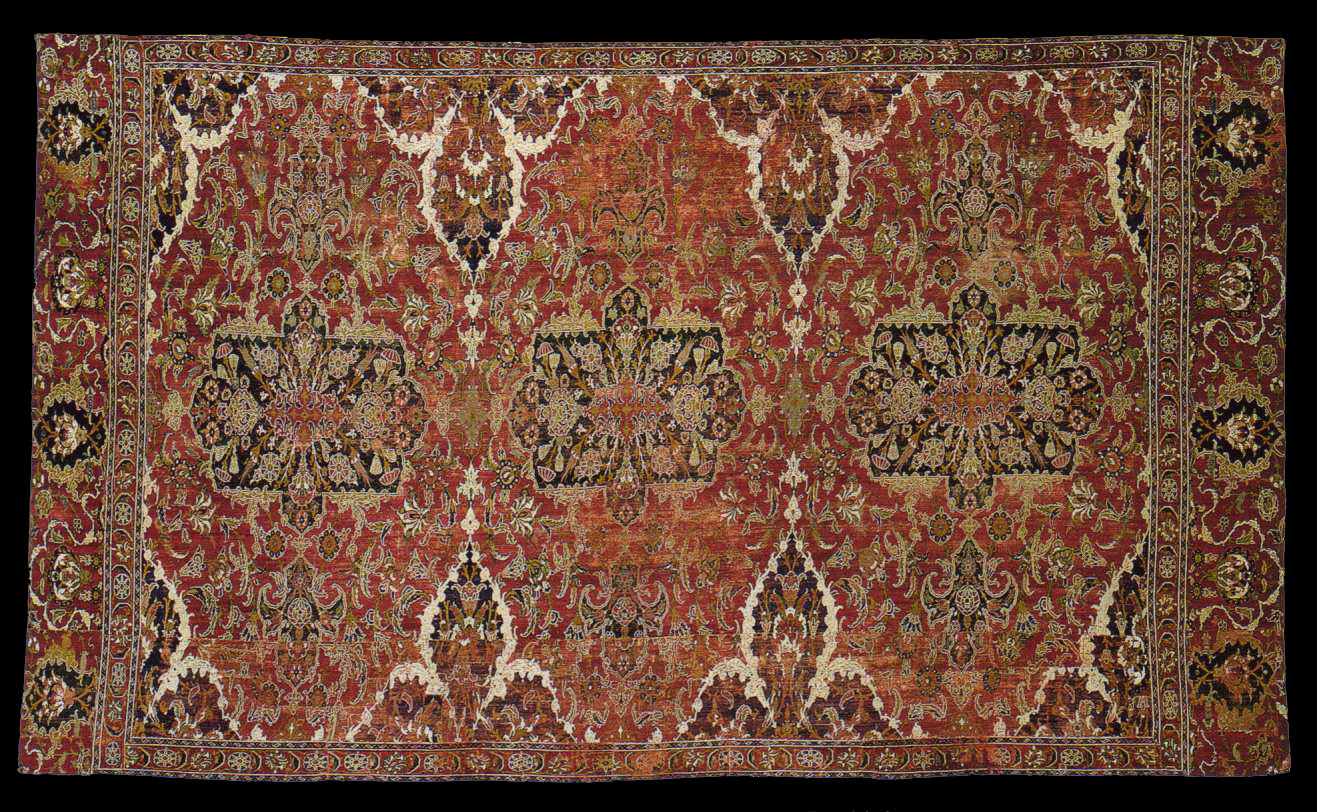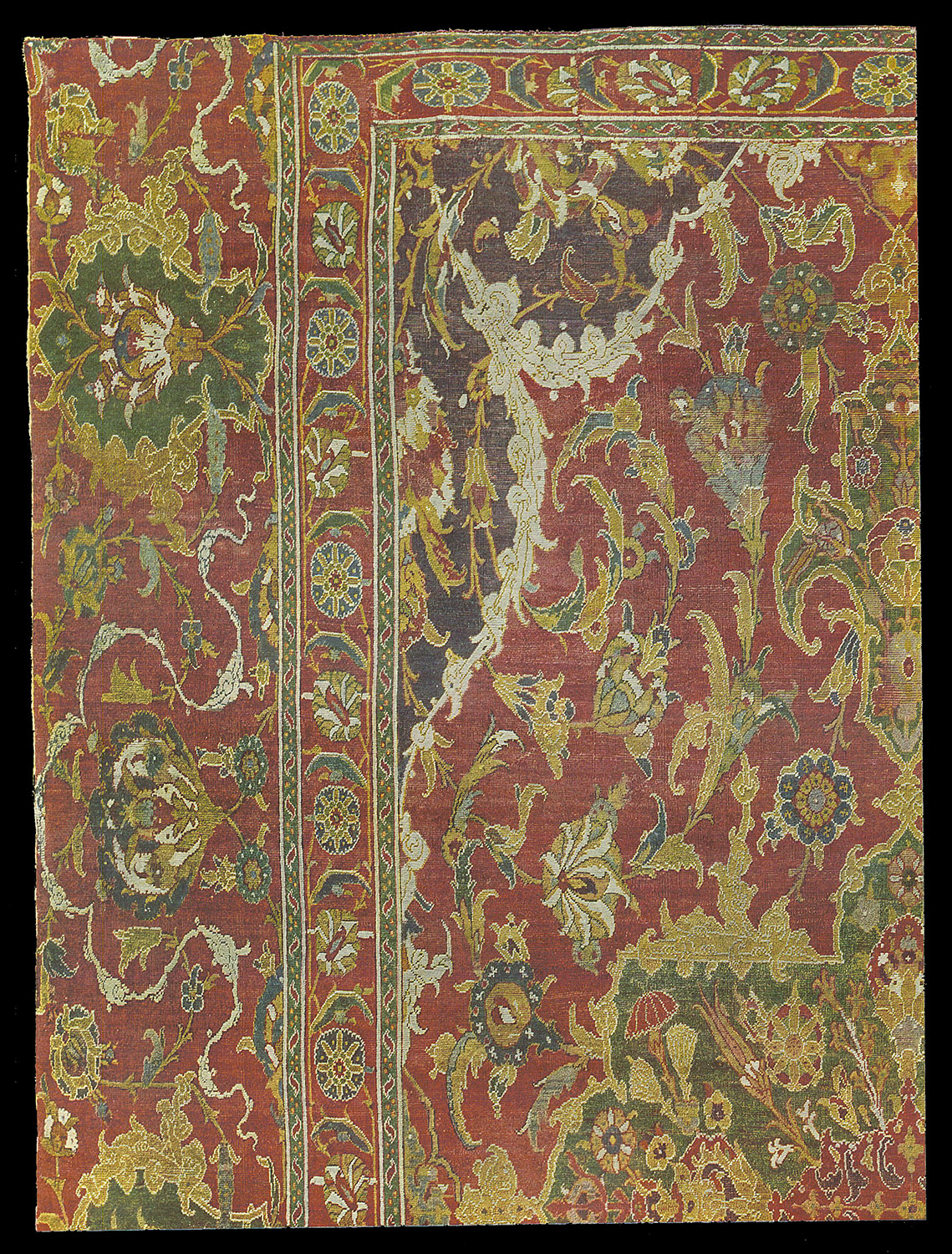TURKISH CARPET, FRAGMENT. COURT MANUFACTORY;
16th CENTURY
Length, 436 cm.; width, 248 cm.
Warp: silk, yellow,
two-fold. To 1 dm. 130 warp threads (= 32 to the inch).
Weft: silk,
dyed red, full and wide. After every row of knots two shoots, one straight
and one wavy.
In places the weft is in thinner threads and taken in
greater number. Knotting: sheep's-wool and cotton, two-fold. The white
knots are made in cotton. To 1 dm. 48 knots
in the length and 65 in the
width (= 12 and 16 to the inch). Knotted on two warp threads.
To 1
square dm. about 3100 knots (= 190 to the square inch). Pile slightly to
the left and lying flat. The cotton-pile now projecting above the rest.
Colours: seven. Ground-colours: deep red (inner field and border),
dark green (cartouches), dark blue (side-compartments). Colours of the
pattern: dark blue, light blue, dark green, light green, white,
yellowish-brown, deep red. Outlines principally white. State Of
preservation: much worn. The ground of the side-compartments has suffered
especially.
Apparently the carpet has been wider, since the border
shows no corner-devices and the fragmentary inner-edging now on the
long-sides is sewn on. The border is no longer complete on any side.
At the ends the middle-stripe and the inner edging of the border are
still preserved, although fragmentary in places. At one of the long sides,
at a distance of about 50 cm. (= 20 in.) from the edge, the carpet has
been cut in the length and the pattern made up by fragmentary insertions.
In the inner field, along the middle line of the length, are three oblong
cartouches placed in a row, joined together by small panels. The
cartouches contain a central device, from which floral stems radiate, on a
green ground, towards the outer edge of the cartouche. Among the palmettes
and blossoms resembling roses hyacinths, tulips and carnations are
scattered. The outline of the cartouche is varied by leafwork and spiral
forms, and from it spring four arabesque-stems. To each of the long sides
of the cartouche are attached panels of curved arabesque form filled with
palmettes and blossoms. From the long sides of the carpet project on
either side into the inner field two complete and two half-arabesque
panels, of curved outline and running to a point, with a blue ground. The
half-panels form the corner-fillings. The outlines, in which an effect of
movement is emphasized, are formed by arabesque stems and elongated
leafwork like those of the cartouches. From the three palmettes filling
each of these panels spring luxuriant floral stems with palmettes and
narrow lancet-leaves; these project into the inner field, filling it in
oval spirals. The border, which is only partly preserved, shows in the
broad middle stripe two kinds ol' palmette motives, pointed outwards, on a
red ground; they alternate in a row, and are connected with one another by
curved stems with rosettes and half-palmettes. One of the palmettes is
more elaborately formed; it sends from the top a floral stem to right and
left, and it is surrounded by a white cloud-band; the other is enclosed by
a cartouche with two flanking arabesques meeting above it. From the points
of these palmettes issue short floral stems. The edgings of the border are
threefold. A broader middle-band contains two continuous intersecting wavy
stems with rosettes, palmettes placed obliquely, and curved lancet-leaves
changing direction in pairs. It is enclosed on each side by a narrow strip
containing S-shaped pointed ovals, changing in direction, and alternating
with small discs in groups of three.
Portion of a closely-similar
carpet is reproduced in colours in Julius Lessing, Vorbilderhefte, Berlin,
1891, Plate 10. The design of the border at the corners in there to be
seen. — Orientalische Teppiche, Vienna, 1892, Plate LXXXV, No. 109. |


